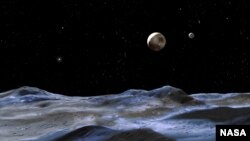Pluto’s moon Charon may have once had subterranean oceans of liquid water, something the U.S. space agency NASA hopes to investigate further when its New Horizons spacecraft swings by just over a year from now.
The notion that there could have been liquid water on a body 29 times further away from the sun than Earth seems far fetched given the surface temperature on Charon is minus 229 Celsius, but NASA scientists say that because the moon may have had an “eccentric,” or slightly oval-shaped orbit, Pluto’s gravity may have caused the interior of the moon to flex, causing enough heat to melt ice.
This phenomenon is believed to be the reason for potential subsurface oceans of liquid water on Jupiter’s moon Europa and Saturn’s moon Enceladus.
NASA hopes New Horizons will be able to provide a detailed analysis of crack patterns on Charon in order to see if there was once water underneath the surface.
"Our model predicts different fracture patterns on the surface of Charon depending on the thickness of its surface ice, the structure of the moon's interior and how easily it deforms, and how its orbit evolved," said Alyssa Rhoden of NASA's Goddard Space Flight Center in Greenbelt, Maryland, in a statement. "By comparing the actual New Horizons observations of Charon to the various predictions, we can see what fits best and discover if Charon could have had a subsurface ocean in its past, driven by high eccentricity."
Charon is the largest moon in the solar system relative to its planet (dwarf planet in Pluto’s case), with one-eighth of Pluto’s mass. Scientists think it was formed after an impact on Pluto caused debris to orbit and gather into several moons.
Researchers said that when Charon initially formed, the gravity between the two bodies would have been enough to cause “their surfaces to bulge toward each other, generating friction in their interiors.”
"Depending on exactly how Charon's orbit evolved, particularly if it went through a high-eccentricity phase, there may have been enough heat from tidal deformation to maintain liquid water beneath the surface of Charon for some time," said Rhoden. "Using plausible interior structure models that include an ocean, we found it wouldn't have taken much eccentricity to generate surface fractures like we are seeing on Europa."
However, the days of liquid water on Charon, if they ever existed, are long over.
The moon’s orbit is now circular and slower, researchers said. Plus, only one side of Charon faces Pluto. Together this would mean that no significant gravitational tides would be generated thus causing any would-be ocean to freeze.
Alan Stern, the principal investigator of NASA's New Horizons mission and and a planetary scientist at the Southwest Research Institute in Boulder, Colorado wrote in an email to VOA that the study “shows just how exciting Pluto's moons could be.”
“We're looking forward very much to exploring this planet and its satellite system for the first time next year with New Horizons to see what they are really like," he wrote.
Rhoden’s research appears in the online journal Icarus.
The notion that there could have been liquid water on a body 29 times further away from the sun than Earth seems far fetched given the surface temperature on Charon is minus 229 Celsius, but NASA scientists say that because the moon may have had an “eccentric,” or slightly oval-shaped orbit, Pluto’s gravity may have caused the interior of the moon to flex, causing enough heat to melt ice.
This phenomenon is believed to be the reason for potential subsurface oceans of liquid water on Jupiter’s moon Europa and Saturn’s moon Enceladus.
NASA hopes New Horizons will be able to provide a detailed analysis of crack patterns on Charon in order to see if there was once water underneath the surface.
"Our model predicts different fracture patterns on the surface of Charon depending on the thickness of its surface ice, the structure of the moon's interior and how easily it deforms, and how its orbit evolved," said Alyssa Rhoden of NASA's Goddard Space Flight Center in Greenbelt, Maryland, in a statement. "By comparing the actual New Horizons observations of Charon to the various predictions, we can see what fits best and discover if Charon could have had a subsurface ocean in its past, driven by high eccentricity."
Charon is the largest moon in the solar system relative to its planet (dwarf planet in Pluto’s case), with one-eighth of Pluto’s mass. Scientists think it was formed after an impact on Pluto caused debris to orbit and gather into several moons.
Researchers said that when Charon initially formed, the gravity between the two bodies would have been enough to cause “their surfaces to bulge toward each other, generating friction in their interiors.”
"Depending on exactly how Charon's orbit evolved, particularly if it went through a high-eccentricity phase, there may have been enough heat from tidal deformation to maintain liquid water beneath the surface of Charon for some time," said Rhoden. "Using plausible interior structure models that include an ocean, we found it wouldn't have taken much eccentricity to generate surface fractures like we are seeing on Europa."
However, the days of liquid water on Charon, if they ever existed, are long over.
The moon’s orbit is now circular and slower, researchers said. Plus, only one side of Charon faces Pluto. Together this would mean that no significant gravitational tides would be generated thus causing any would-be ocean to freeze.
Alan Stern, the principal investigator of NASA's New Horizons mission and and a planetary scientist at the Southwest Research Institute in Boulder, Colorado wrote in an email to VOA that the study “shows just how exciting Pluto's moons could be.”
“We're looking forward very much to exploring this planet and its satellite system for the first time next year with New Horizons to see what they are really like," he wrote.
Rhoden’s research appears in the online journal Icarus.











